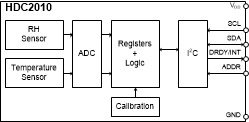TIDUF52 December 2023 MSPM0L1303 , MSPM0L1304 , MSPM0L1305 , MSPM0L1306 , MSPM0L1343 , MSPM0L1344 , MSPM0L1345 , MSPM0L1346
- 1
- Description
- Resources
- Features
- Applications
- 6
- 1System Description
- 2System Overview
- 3Hardware, Software, Testing Requirements, and Test Results
- 4Design and Documentation Support
- 5About the Author
2.3.6 HDC2010
The HDC2010 is a highly-integrated digital humidity and temperature sensor that incorporates both humidity sensing and temperature-sensing elements, an analog-to-digital converter, calibration memory, and an I2C interface that are all contained in a 1.5-mm × 1.5-mm DSBGA package. The HDC2010 provides excellent measurement accuracy with very low power consumption and features programmable resolution for both humidity and temperature:
- Temperature resolution [9, 11, 14]
- Humidity resolution [9, 11, 14]
The conversion time during measurements is dependent upon the configured resolution for humidity and temperature, which can be configured for the best available power consumption.
The HDC2010 device incorporates a state-of-the-art polymer dielectric to provide capacitive-sensing measurements. As with most relative humidity sensors that include this type of technology, the user must meet certain application requirements to make sure of the best device performance for the sensing element. The user must:
- Follow the correct storage and handling procedures during board assembly. See the Humidity Sensor: Storage and Handling Guidelines application report for these guidelines.
- Protect the sensor from contaminants during board assembly and operation.
- Reduce prolonged exposure to both high temperature and humidity extremes that can impact sensor accuracy.
- Follow the correct layout guidelines for best performance. See the Optimizing Placement and Routing for Humidity Sensors application report for these guidelines.
 Figure 2-20 HDC2010 Functional Block Diagram
Figure 2-20 HDC2010 Functional Block Diagram